by Winding Pathways | Nov 20, 2016 | Birds, Nature
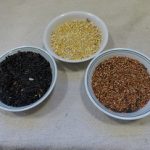
Sunflower seed, cracked corn and Milo mix.
Cold weather in the northern hemisphere and the Holiday Season everywhere are upon us and many gifts for bird lovers fill store shelves. But, shopping for seeds to fill the backyard feeder can be confusing and even frustrating. Many types of seed and mixes are for sale. Some blends are designed to attract specific species, like cardinals, while others target a diversity of birds. Cheap blends appeal mostly to house sparrows and blackbirds, species most people prefer to not attract.
Winding Pathways suggests keeping seed buying simple. We have a favorite seed, one we avoid, and one that we use in a special way. We rarely buy cheap mixes that song birds really do not like and that are sold in big box, chain and grocery stores at inflated prices. Farm stores often sell better mixes at lower cost. Neither of these types of stores have knowledgeable staff to help new comers to winter bird feeding. Specialty bird feeding stores offer the highest quality seed and staff up-to-date in what song birds feed on. And, yes, you pay a bit more – and we find it worth the cost. Less wasted seed and higher satisfaction for homeowners and the birds!
THE BEST SEED FOR WILD BIRDS
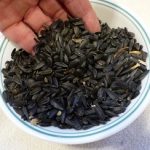
Sunflower delivers the highest quality feed for wintering birds.
Of the many outstanding seeds for feeding birds we like black oil sunflower the best. It’s relatively inexpensive and devoured by chickadees, titmice, nuthatches, woodpeckers, cardinals, and many other species. We don’t mind that birds drop hulls to the ground but for people who dislike this mess, hulled sunflower seed can be purchased and is excellent. It is kernels of larger culinary sunflower seeds, sometimes called gray stripe seed. Hulls have been removed and seed is much more expensive but loved by birds. Most sunflower seeds are produced on farms in the Dakotas and Minnesota.
THE WORST SEED
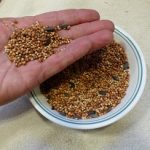
Songbirds do not like the cheap mix.
The worst seed is Milo. It is a common ingredient in cheap mixes and sometimes is sold as “bird seed.” Milo is grown on arid land in the Great Plains and is mainly used for livestock feed. The young plant looks like corn but unlike corn its seeds form at the top of the plant. Few birds like the astringent seeds, although they will sometimes eat it if nothing else is available and they are hungry. Less desirable species, like house sparrows and blackbirds will eat it. Milo seeds are round, slightly reddish, and about twice the size of somewhat similar millet. Try to avoid it.
IN BETWEEN SEEDS
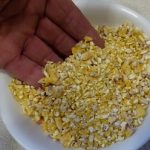
An inexpensive alternative to the higher quality feed.
An excellent inexpensive seed that will be eaten by many birds is cracked corn. Desirable birds prefer sunflower seeds, but we often sprinkle some cracked corn on the ground to keep sparrows and wild turkeys happy and, hopefully, away from our sunflower seed. Another seed of “in between” value is millet. These are tiny round white or yellowish seeds often found in inexpensive mixes. Mourning doves, juncos and other ground feeders enjoy eating it. So do house sparrows.
Learning to identify seeds helps a customer purchase the best seed at the lowest cost. Reading labels helps as most manufacturers list the contents of their seed packages. Happy Holidays to you and the birds you love to feed!
by Winding Pathways | Nov 10, 2016 | Birds, Nature
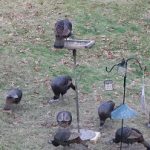
Turkeys and squirrels would make short work of seed, leaving none for the small birds.
Nearly everyone who feeds wild birds sees squirrels gobbling up expensive seed. Elaborate and expensive feeders help birds eat while excluding squirrels. We use a different method.
Plenty of squirrels make Winding Pathways home. So do wild turkeys. We enjoy watching them and don’t mind giving them some seed. Unfortunately, they come in droves and wolf down all the seeds. Each morning we sprinkle some seeds on the lawn for both turkeys and squirrels but we needed to keep them away from a feeder favored by cardinals, chickadees titmice, and other birds.
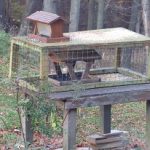
This homemade excluder seems to stop squirrels and turkeys while allowing in songbirds.
We built a simple but effective squirrel and turkey excluder out of scrap lumber. It’s merely a rectangular box two feet wide and four feet long. The frame is made of 2×2 lumber, the top is of treated ½ inch plywood, and the sides are of 2×2 inch mesh heavy wire. There is no bottom.
We placed a feeder on a homemade picnic table and put the turkey and squirrel excluder over it. One end of the excluder is hinged to the table, making it easy to lift the other side to fill the feeder.
So far squirrels and turkeys have not been able to infiltrate the excluder and stay outside enjoying the cracked corn we’ve spread specially for them.
by Winding Pathways | Sep 20, 2016 | (Sub)Urban Homesteading, Foraging, Mammals, Nature

A variety of fencing keeps deer and rabbits out of the garden.
Like millions of American homeowners we at Winding Pathways have a love/hate relationship with deer. Few animals are as beautiful as a peaceful doe nursing her fawns or as majestic as a powerful buck sporting husky fall antlers. But a love of deer only goes so far. Anger mounts quickly when they devour flowers and vegetables, girdle valuable trees, or dart in front of the car on a dark night. Last year we planted a small river birch that was growing well until a buck utterly destroyed it while rubbing his antlers on it. Frustrating!
Until about 25 years ago deer mostly lived in large forests and rarely ventured into town or suburbia, but as their rural population grew they moved right into town. Most suburbs have plenty of wooded pockets where deer can hide and nutritious forage in parks, gardens, and yards. Today deer are amazingly abundant in suburbia, where they prance up and down streets and dine on valued vegetation.
DEER DAMAGE
Deer generally do two types of vegetation damage. One’s relatively easy to prevent, while the other is more challenging.
RUBS: Antlers form during warm months as a blood rich skin, called velvet, nourishes fast growing bone like antlers that are mostly calcium. By September, antlers have reached full growth. Velvet dies and dries, and bucks remove it by rubbing antlers against small trees. They prefer saplings a few inches in diameter. Rubbing often girdles and kills the tree, and deer always seem to attack the most valuable tree in the yard. It’s infuriating and costly. Although velvet is mostly gone by early October deer continue to bang and rub their antlers against trees throughout the fall.
The Cure: Fortunately there’s an easy way to prevent rubbing.
At Winding Pathways we use heavy wire in 2” X 4” mesh that we buy in 50 foot rolls. It’s relatively easy to cut an eight foot length of fencing using wire cutting pliers. Once we have the section cut we ring it around the tree and hold the ends closed with cable ties. Usually one metal fence post driven 18” into the ground will hold the wire in place. Sometimes two posts placed on opposite sides of the tree are needed. We attach the wire mesh to the post using big cable ties. The wire stays in place year round until the tree is at least 4 inches in diameter and no longer threatened by rubbing.

Attache zip ties firmly to a post.
What You Need to Make a Wire Ring
- Wire: We buy rolls of 2”X4” four foot tall galvanized wire mesh from a farm or building supply store. Many brands and types of wire mesh are for sale but we prefer Red Brand. It is stiff and strong and we usually only need one fence post to hold it up. Red Brand fencing is made in the US. Less sturdy wire mesh is cheaper but bends easily, rusts more quickly, and usually requires a few fence posts to hold it in place.
- Pliers: We unroll about eight feet of the wire roll on the driveway for cutting. Any type of cutting pliers will work to cut off a section but we find “Bernard” pliers perfect for the task. These are usually made for anglers and have a wire cutter and spring that automatically opens the pliers after a cut. They make slicing off a section easy and fast.
- Fence Post: With stiff wire mesh one fence post will hold a ring of wire in place around a tree. Wire mesh that readily bends may need two or three posts. We buy 6 foot posts, called T posts, at farm or building supply stores and pound them 18 inches into the ground 12” to 20” out from the tree’s trunk. A small sledge hammer makes a handy pounding tool. We then form a circle of the wire panel around the tree and fasten the ends together.
- Cable ties, sometimes called nylon zip ties, make joining the ends of the wire mesh and attaching the wire to the fence post easy. The ties come in various sizes. It takes big ones to run through the wire mesh and secure around the post. Twist wire also works to hold the ends together or attach the wire mesh to the post.
Putting a ring of wire around valuable young trees is almost certain to protect them from rubbing and browsing. Just be sure to do it before damage starts.
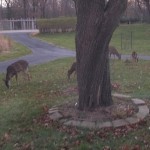
At Winding Pathways deer come into the yard. We protect young trees with fencing as seen in the back to the right.
LUNCH AND DINNER WITH BREAKFAST TOSSED IN: Deer love eating many landscape and vegetable plants. Although they have preferences, the hungrier the deer, the more likely they are to even eat plants they generally dislike. Garden books often list species of plants that deer do and don’t like to eat but beware, like humans, individual deer have food preferences. Although most deer may not like a particular plant species, others may consider it a dining delight. Deer seem to have regional tastes, so the plants they don’t like in Connecticut may be gourmet fare in Alabama or Iowa. Unfortunately, many plants that deer relish are the same ones homeowners like to plant, so protecting them is vital to success.
Damage to trees by rubbing is seasonal and normally only happens in the fall. In contrast browsing damage happens all year with deer generally eating softer vegetation during warm months and twigs during winter.
The Cure: Preventing deer from eating valued vegetation is difficult but here are some ways to either eliminate or stop it:
Fences
No doubt about it. A sturdy fence keeps deer away from plants and prevents damage. Fencing has downsides. It’s expensive, often unsightly, and it requires maintenance. A fence can ring an entire property or just an area that needs protection, such as around the vegetable garden. Generally there are two types of fence used to prevent browsing.
- Electric fences work well. Many newer ones are moveable and easy to install. Electric fences don’t need to be very tall. They are relatively expensive but their biggest disadvantage is that they sometimes give a shock to a careless homeowner or even a child. Many towns ban electric fences, so be sure one is legal before you buy one. We like fences made by Premier.
- Nonelectric fences work well to exclude deer but also have disadvantages. They are laborious to install and are relatively expensive. They can be made of heavy duty nylon or wire mesh. Deer are amazing high jumpers and can clear a six foot fence, so a deer proof fence should be eight feet tall!
Repellents
A good fence will prevent deer damage by keeping hungry animals away from desirable plants. Repellents are less certain but can help reduce damage. Repellents are most helpful when temporary protection is needed or where fences won’t work and they are less expensive. They have these disadvantages:
- Need to be reapplied often and always after a rain.
- Sometimes smell strongly.
- May not be suitable for use on vegetables.
- Only somewhat deter deer from snacking.
Our good friends Dave and Sue Kramer own Kramer’s Flower Farm and produce thousands of varied colored day lilies every year. Visit their farm in mid-summer and it is a sea of blooms. People love looking at colorful flowers but deer consider them lunch. Kramer’s farm is surrounded by woods, so they have to be vigilant in keeping deer way from their crop. Dave uses a home-made spray that keep deer at bay.
Kramer’s Deer Repellent Recipe
Ingredients:
One gallon of water.
Three egg yolks
One teaspoon garlic powder.
One teaspoon cayenne pepper finely ground
Directions:
Add ingredients and shake well. Leave in the sun for a couple of days. Shake again and filter through an old nylon stocking to remove lumps or they will clog the sprayer. Put in a standard sprayer and spray plants. Treatment needs to be repeated often and after every rain.
Deer don’t like the smell or taste of rotten eggs. Who would? Anyone who would rather not make their own egg based spray can buy commercial mixes. The one we use is called Deer Stopper and is made by the Messinas Company. The label says it’s made of putrescent whole egg solids, rosemary oil, mint oil and several inert ingredients.
After buying several inexpensive sprayers that clogged we bought a Stihl brand sprayer that works well and seems less likely to clog.
Whether using a home-made or commercial repellent remember it needs to be reapplied relatively often and always after a rain.
Direct Action
Winding Pathways is near Cedar Rapids, Iowa. Several years ago the City Council approved allowing citizens to hunt deer using archery equipment. Hunters need to prove proficiency with their equipment and special rules are in place to ensure safety. Each year hunters convert several hundred suburban and urban deer into chops and steaks. Deer meat is “free ranging, local, organic” and delicious.
Each year we harvest a deer from our property. This doesn’t stop deer damage but does provide us with food, and if enough people each take a deer, their population density and, thus, damage will decline. So, if it’s legal in your area, consider converting a deer to food. Normally a state and sometimes a local permit is needed. Look for a future Winding Pathways blog on how to harvest and dress a deer.
by Winding Pathways | Sep 12, 2016 | (Sub)Urban Homesteading, Garden/Yard, Nature, Solitude, Wonderment

This intriguing winding path beckons visitors into the backyard.
A short winding pathway around the home of Scott and Jan Overland leads to a wondrous backyard that’s an oasis of privacy and peace within bustling Cedar Rapids, Iowa. Butterflies flitted about as a hummingbird sipped nectar from an obedient plant as we toured the yard.
“When we first moved here the landscaping was traditional and sparse, and at first we tried to maintain it that way. But then we changed course and began adding interesting plants that make our yard beautiful. It’s a fun project,” said Scott Overland, who is a professional financial adviser and member of the Cedar Rapids City Council.

Rich and Scott share backyard delights
A special aspect of the Overland’s yard is how it has engaged them in nature and the environment. “We visit nurseries to learn about plants and sometimes add new ones. It’s a wonderful learning experience.” he said. A barred owl occasionally serenades them from a hemlock tree near the house bringing sounds of the deep woods to their neighborhood.

Scott shows the French drain, named for its inventor, Henry French, from Massachusetts in the mid 1800s.
There’s more. The diverse and beautiful yard absorbs storm water better than if it were traditionally landscaped. “Nowadays storms have more intensity than they once did and our yard absorbs most of the rain that falls on it. We installed a French drain to further help water enter the soil and avoid flowing into storm sewers that would add to downstream flooding,” he said.

Glimpses of comfort and color welcome visitors.
The Overlands demonstrate that a yard needn’t be big to be beautiful and ecologically healthy. They’ve created a magical space on a quarter acre lot not far from downtown.
by Winding Pathways | Sep 5, 2016 | Flowers/Grasses, Nature, Reflections/Profiles, Wonderment
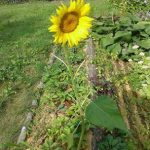
A sweet tribute to summer.
A short note from Jan Watkins about her summer companion.
“This lone sunflower volunteered to be in my garden. It looks in at me and makes me smile each day. It’s the little things. The special thing about this flower besides choosing my garden in which to bloom, is that it’s not even looking at the sun. It looks in at me!! Now that’s sweet!”
Thanks, Jan, for sharing on Winding Pathways!














